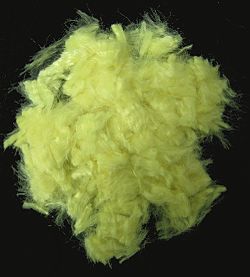Overview of Kevlar
Kevlar, a remarkable synthetic fiber developed by Stephanie Kwolek at DuPont, is renowned for its exceptional strength, heat resistance, and diverse applications across various industries. This para-aramid material has revolutionized protective gear, industrial applications, and advanced technologies due to its unparalleled properties.
Development and Properties
Stephanie Kwolek’s groundbreaking work led to the creation of Kevlar in the early 1960s, which was introduced in 1971. Kevlar’s molecular structure is characterized by numerous inter-chain bonds, which provide it with extraordinary tensile strength. In fact, Kevlar boasts a tensile strength ten times greater than steel on an equal weight basis[3]. This exceptional strength is attributed to the intermolecular hydrogen bonds formed within the polymer chains[1].
Applications
Kevlar’s versatility and strength have made it indispensable in various fields. Initially conceived as a lightweight alternative for steel bracing in vehicle tires, Kevlar has found widespread use in ballistic body armor, reinforcing tires, brake linings, cables, and aerospace applications[4]. Its high tensile strength-to-weight ratio makes it ideal for applications requiring durability without adding excessive weight.
Manufacturing and Variants
Kevlar is synthesized from monomers like para-phenylenediamine and terephthaloyl chloride, with production involving mechanical drawing to orient polymer chains in the fiber’s direction[1]. Different grades of Kevlar are available to suit specific needs: from Kevlar K29 used in industrial settings to specialized variants like Kevlar K129 for ballistic applications and aerospace use[1][4].
Strengths and Limitations
One of Kevlar’s key strengths lies in its ability to absorb and dissipate energy upon impact, making it highly effective in ballistic resistance. Additionally, its flame-resistant nature provides protection against thermal hazards up to 800 degrees Fahrenheit[3]. However, exposure to UV light can degrade Kevlar over time, necessitating protection against sunlight when used outdoors[1].
Future Prospects
As technology advances and new challenges emerge, the demand for materials like Kevlar continues to grow. Its unique combination of strength, heat resistance, and versatility positions it as a crucial component in enhancing safety and performance across a wide range of applications.
In conclusion, Kevlar stands as a testament to human ingenuity and innovation, offering unparalleled strength and protection across diverse industries. From saving lives through body armor to reinforcing critical infrastructure components, Kevlar’s impact on modern society is profound and enduring.
- https://en.wikipedia.org/wiki/Kevlar
Kevlar – Wikipedia
This page provides a comprehensive overview of Kevlar, a heat-resistant para-aramid synthetic fiber with a molecular structure of many inter-chain bonds that make it incredibly strong. It is best known for its use in ballistic body armor, but it also has many other applications because of its high tensile strength-to-weight ratio. The page includes information on the history of Kevlar, its chemical structure, production, and uses. - https://en.wikipedia.org/wiki/Bulletproof_vest
Bulletproof vest – Wikipedia
This page provides information on bulletproof vests, including their history, design, and materials. It explains that Kevlar is a synthetic fiber woven into a fabric and layered that, by weight, has five times the tensile strength of steel. The page also includes information on the development of Kevlar body armor and its use by law enforcement officers. - https://www.dupont.com/what-is-kevlar.html
What is Kevlar®?
This page, provided by DuPont, the company that invented Kevlar, explains the properties of Kevlar in detail. It explains that Kevlar is a heat-resistant para-aramid synthetic fiber with a molecular structure of many inter-chain bonds that make it incredibly strong. The page includes information on Kevlar’s tensile strength, ballistic resistance, cut and puncture resistance, and heat resistance. - https://en.wikipedia.org/wiki/Aramid
Aramid – Wikipedia
This page provides information on aramids, a class of heat-resistant and strong synthetic fibers that includes Kevlar. It explains the chemical structure of aramids, their production, and their properties. The page includes information on the uses of aramids, including flame-resistant clothing, heat-protective clothing and helmets, body armor, composite materials, asbestos replacement, hot air filtration fabrics, and tires.
Kevlar (para-aramid) is a strong, heat-resistant synthetic fiber, related to other aramids such as Nomex and Technora. Developed by Stephanie Kwolek at DuPont in 1965, the high-strength material was first used commercially in the early 1970s as a replacement for steel in racing tires. It is typically spun into ropes or fabric sheets that can be used as such, or as an ingredient in composite material components.

| |

| |
| Names | |
|---|---|
| IUPAC name
Poly(azanediyl-1,4-phenyleneazanediylterephthaloyl)
| |
| Identifiers | |
| ChemSpider |
|
| Properties | |
| [-CO-C6H4-CO-NH-C6H4-NH-]n | |
Except where otherwise noted, data are given for materials in their standard state (at 25 °C [77 °F], 100 kPa).
| |
Kevlar has many applications, ranging from bicycle tires and racing sails to bulletproof vests, all due to its high tensile strength-to-weight ratio; by this measure it is five times stronger than steel. It is also used to make modern marching drumheads that withstand high impact; and for mooring lines and other underwater applications.
A similar fiber called Twaron with the same chemical structure was developed by Akzo in the 1970s; commercial production started in 1986, and Twaron is manufactured by Teijin.
English
Alternative forms
- Kevlar
Etymology
Kevlar, a trademarked name
Pronunciation
- (General American) IPA(key): /ˈkɛvlɑɹ/
- (Received Pronunciation) IPA(key): /ˈkɛvlɑː/
Noun
kevlar (countable and uncountable, plural kevlars)
- (uncountable) (Fabric, cordage, etc made of) aramid fiber, an exceptionally strong, light, man-made fibre used to strengthen cables and sheet materials, e.g.